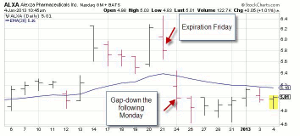Although in-the-money calls are almost always exercised after market close on expiration Friday, there are exceptions, writes Alan Ellman of TheBlueCollarInvestor.com, and you need to know what circumstances might arise triggering this exception.
When studying the basics of option investing we learn that the option holder of an in-the-money strike has a certain amount of intrinsic value, which appears to be profit that would never be bypassed. For example, if we (as covered call writers) sold a $50 call and the stock was trading @ $52 @ 4 pm EST on expiration Friday, the holder can exercise the option and buy our shares for $50 and sell for a profit after the market opens the following week. In addition, the Options Clearing Corporation has provisions for the automatic exercise of in-the-money options at expiration, called exercise by exception. Exercise will occur automatically if the strike is $0.01 or more in-the-money. Some brokerages may not have the same threshold as the OCC but $0.01 is very common. We, as call sellers, have no control over exercise. That is up to the holder. Why then are some of our in-the-money calls not exercised?
During and After-Hours Trading
For Blue Collar Investors like us the ability to trade ends @ 4 pm EST and most options expire on the third Friday of the month (technically the Saturday after the third Friday but we cannot trade on Saturday). However, professional traders have the ability to trade for 90 minutes more, until 5:30 pm EST. Now the options-related trading is based on the composite or consolidated price based on the 4 pm price of the underlying security. The trader in this instance has until 5:30 pm to let the OCC know if he wants his options exercised. Those in-the-money options will be automatically exercised unless the trader provides a contrary exercise notice (“do not exercise”) to the OC in which case these options will not be exercised.
NEXT PAGE: A Real-Life Example |pagebreak|
Real-Life Example
- Purchase ALXA @ $5.30
- Sell a one-month $5.50 call @ $0.95
- At 4 pm expiration Friday ALXA was trading @ $5.79, the strike $0.29 in-the-money
- Exercise of option and sale of the shares @ $5.50 was anticipated
- The option was NOT exercised and the shares were NOT sold
- ALXA opened @ $5.18 on Monday morning after expiration Friday
- Several days later the stock was trading @ $4.82
The chart below shows the gap-down from expiration Friday to the following Monday:
ALXA gaps down
What Caused This Unusual Circumstance?
When this BCI member first told me about this trade, the first thought I had was why was the initial one-month return so high?
$95/$530 = 18%
Obviously the implied volatility of the option was high so I started my research. It turns out there was an FDA approval/disapproval result due out prior to expiration. The results were divulged 10 minutes prior to 4 pm on expiration Friday. Although the initial results appeared positive (the company received approval), the professionals had 90 minutes to decide if they wanted to take possession of the shares @ $5.50. As they studied the details of the ruling many decided not to. 47% of those holding the $5.50 calls sent contrary exercise notices to the OCC and those in-the-money calls expired without exercise. On Monday, the market agreed and the shares continued to fall.
Lessons Learned
The first lesson is to avoid stocks with extremely high implied volatility. I will rarely select an underlying that generates more than 6-7% for a one-month return for at-the-money strikes. The second lesson is that if you do find yourself in that position, close the short call and perhaps the entire position prior to the event in question.
Conclusion
Although in-the-money calls are almost always exercised after 4 pm EST on expiration Friday, there are exceptions. These unusual circumstances occur when professional traders make after-hour decisions to send contrary exercise notices to the OCC because an event near or just after market close made ownership of the underlying undesirable in their eyes.
By Alan Ellman of TheBlueCollarInvestor.com











